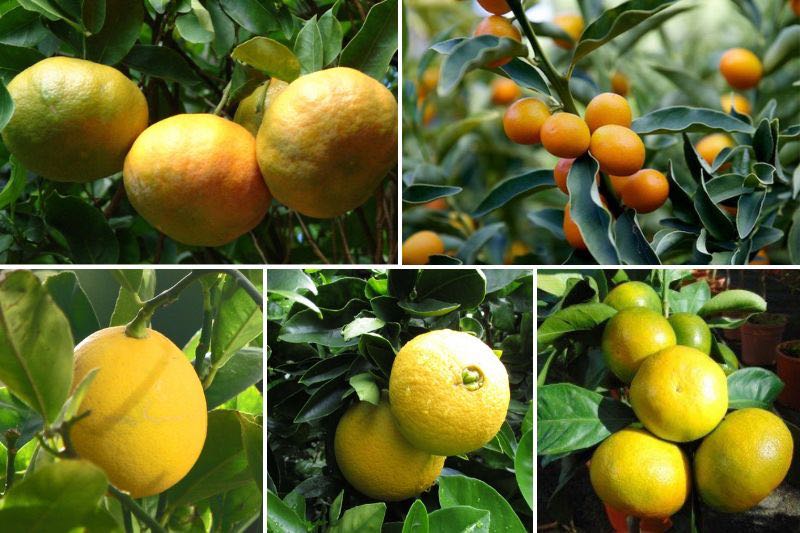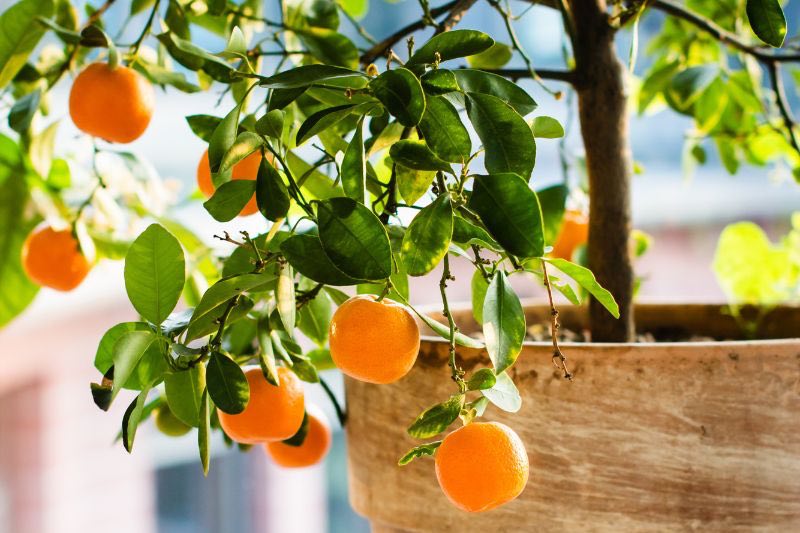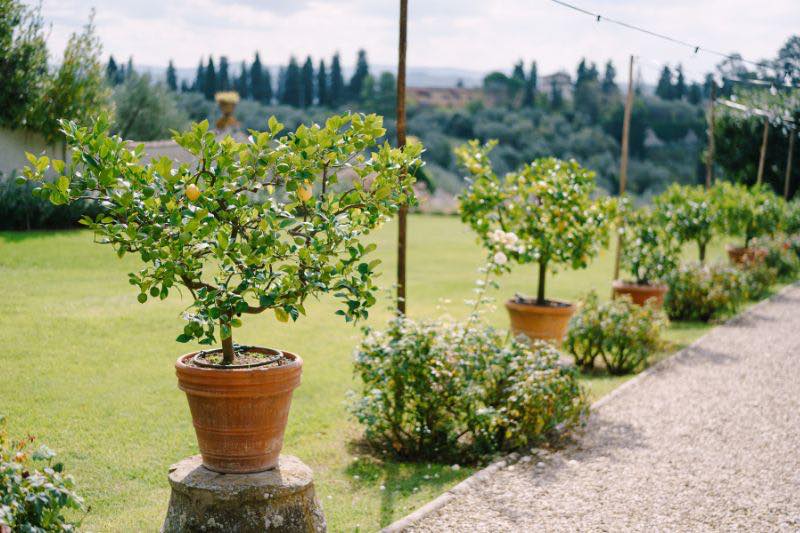Citrus trees (Citrus in Latin) have several assets: evergreen foliage bringing a touch of exoticism all year round, beautifully scented flowering and, above all, tasty acidic and vitamin-rich fruits.
These bushes are however rather sensitive to cold: they can generally only be grown in the ground in the mildest regions around the Mediterranean. But the good news is that they grow very well in pots! This allows them to be overwintered under cover without any problems, before being brought back out in spring to brighten up gardens, terraces or balconies.
Cultivation is not particularly difficult, but will require some precautions to ensure good fruiting and keep a citrus tree in good health. Here are the different steps to follow to plant or repot your citrus trees properly.
Which citrus tree varieties to choose?
There are many varieties of citrus trees. Most can be grown in pots without any problems. Opt rather for the smaller varieties, not exceeding 2.5 metres in height at maturity.
Choose for example:
- the Meyer lemon tree Citrus x meyeri 'Meyer' (2.5 metres in height and 1.5 metres in spread);
- the kumquat Fortunella margarita ‘Nagami’ (2.5 metres in height and 1.5 metres in spread);
- the mandarin tree Citrus reticulata ‘Keraji’ (1.5 metres in all directions);
- the orange tree Citrus sinensis ‘Washington Navel’ (2.5 metres in height and 2 metres in spread);
- the mandarin tree Citrus unshiu ‘Satsuma’ (2.5 metres in height and 1.5 metres in spread);
- the Chinese mandarin tree Citrus myrtifolia (2 metres in height and 1.5 metres in spread).
If you do not have an unheated room to overwinter your citrus tree (greenhouse, conservatory...), opt for the calamondin. This is indeed one of the rare citrus varieties capable of withstanding the hot, dry air of our interiors.
-> Also discover our selection of 7 citrus trees to grow in pots



When to plant or repot citrus trees?
The ideal time to plant your citrus tree in a pot is in spring, once the last frosts have passed. Proceed between March and May, depending on the region.
Repotting takes place at the same time, every 2 to 3 years or so. It will also depend on the natural growth of your citrus tree. In years when you do not repot your citrus tree, we recommend top-dressing. This simply involves carefully removing the top layer of compost (about 3 to 5 cm), to replace it with fresh compost.
Planting citrus trees in pots
The container
For your citrus tree in a pot, choose a container that is necessarily pierced, so that rainwater or irrigation water can drain away without stagnating.
Terracotta pots allow better aeration of the compost, but will require more attention when it comes to watering (the water evaporates more quickly than in a plastic pot). Wooden containers are also ideal for growing citrus trees in pots. Avoid water reservoir pots, which induce harmful stagnant moisture for our citrus trees.
In terms of size, choose a container whose volume is about 3 times larger than the root ball (root system) for a first installation. For repotting, simply choose a container slightly larger than the previous one.
To facilitate the movement of heavy specimens before winter, you can opt for a container on wheels.
The compost
Citrus trees appreciate soils rich in organic matter, but well drained to prevent water from stagnating.
You can choose a compost for Mediterranean plants or a special citrus compost, which promote plant growth, support flowering and fruiting.
For planting or repotting your citrus tree in a pot, you can also make your own mix with approximately:
- 2/3 of horticultural compost of good quality or garden soil that is not calcareous;
- 1/3 of coarse sand or gravel to promote drainage;
- 1 to 2 handfuls of homemade compost or well-rotted manure.
Planting
Before planting, place your citrus tree in a bucket or basin with a little water, so that the root ball can rehydrate. This will also make it easier to remove the plant from its container.
- Install a drainage layer of about 5 cm at the bottom of your container: clay pebbles, gravel, terracotta shards or even pumice.
- Complete with the compost mix until 2/3 of the container is filled.
- Remove the citrus tree from its pot, gently untangle the root system if necessary. Place it then in the centre of the container, before completing with compost without burying the collar (junction between the root system and the stem).
- Firm with your fingers around the collar.
- Water generously.
- Add a mulch at the base of the plant (dead leaves, straw, wood chips, vegetable husks...).
- Place a saucer under the container.
Exposure
Sun-loving plants, citrus trees appreciate heat and light. Place them therefore in a sunny position, but sheltered from prevailing and drying winds. Citrus trees in pots will ideally be placed outside from spring to autumn, in the garden, on the terrace or balcony.
As mentioned earlier, only the calamondin can be grown indoors. In this case, to ensure fruiting, open your windows regularly during flowering to attract pollinating insects.
Maintenance of citrus trees in pots
Citrus trees are not difficult to grow, but require some care. Frequent watering and regular fertilisation will allow them to develop well and fruit.
Watering
Water management is one of the key points for successfully growing a citrus tree in a pot since:
- it dislikes drought (its root system is superficial, remaining near the surface);
- in a container, the compost dries out much more quickly than in the ground and the plant cannot seek water deep in the soil.
Water therefore your bush regularly from spring to autumn (once to several times a week depending on weather conditions). Proceed as soon as the compost is dry on the surface. Always prefer rainwater, less chlorinated and calcareous than tap water (or let it sit for a few days before watering).
Empty the saucer after about twenty minutes after watering or after heavy rain. Because if citrus trees need water, they hate stagnant moisture!
Reduce watering in winter.
Yellowing leaves or foliage pointing downwards can be a sign of lack of water. On the contrary, leaves pointing upwards can indicate excess water. If you notice one of these phenomena, feel the compost on the surface to check if it is dry or moist.
Avoid watering the foliage: ideally water at the base of the plant or install a drip system in the pot. Only mist the foliage in case of indoor cultivation (outside the hours when the sun's rays are hot).
A layer of mulch installed at planting time will help keep the compost moist longer, and thus space out watering.
Fertilisation
As with watering, fertilisation must be regular and monitored. Citrus trees are indeed greedy plants. In pots, the compost also loses its nutrients much more quickly.
Fertilisation will help prevent deficiencies, optimise flowering, fruiting and fruit growth. It will be implemented from spring to autumn, then stopped during winter.
Choose a specific product, such as a fruit tree fertiliser or a Mediterranean plant fertiliser. You can opt for a fast-release liquid fertiliser, which will be renewed regularly, or for a slow-release solid fertiliser. Favour fertilisers rich in potash
![Planting or repotting a citrus plant in a pot [plant_guide title="Repotting Citrus Plants"]
When it comes to [common_name plant="citrus"] plants, repotting is an essential step to ensure their well-being. Here are a few tips to guide you through the process:
1. **Timing**: The best time to repot your [common_name plant="citrus"] is in spring, just before the growing season begins.
2. **Choosing the Right Pot**: Select a pot that is slightly larger than the current one, with good drainage holes to prevent waterlogging.
3. **Soil Mix**: Use a well-draining potting mix suitable for [common_name plant="citrus"] plants, or create your own mix with equal parts of potting soil, sand, and perlite.
4. **Repotting Process**:
- Gently remove the plant from its current pot, being careful not to damage the roots.
- Loosen the roots and remove any dead or rotting ones.
- Place the plant in the new pot and fill in the gaps with fresh soil mix.
- Water the plant thoroughly and place it in a sunny spot.
5. **Aftercare**: Keep the plant well-watered but avoid waterlogging. Fertilize with a balanced fertilizer during the growing season.
By following these steps, you can ensure that your [common_name plant="citrus"] plant thrives in its new pot and continues to bear delicious fruits for years to come. Happy gardening!
[/plant_guide]](https://en.promessedefleurs.eu/blogwp/wp-content/uploads/2023/01/Comment-planter-ou-rempoter-un-agrume-en-pot-.png)




































Comments